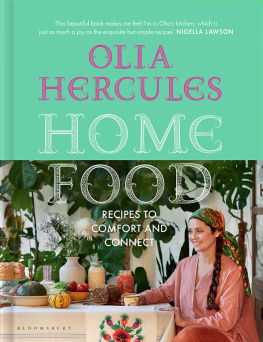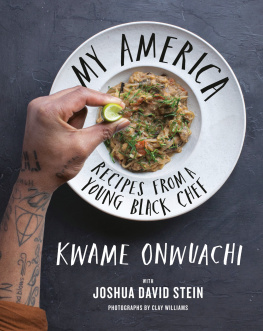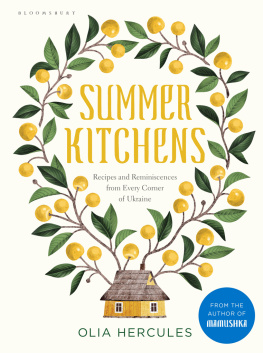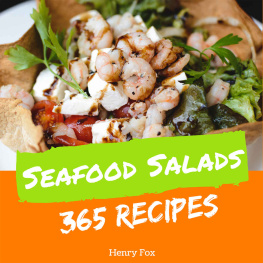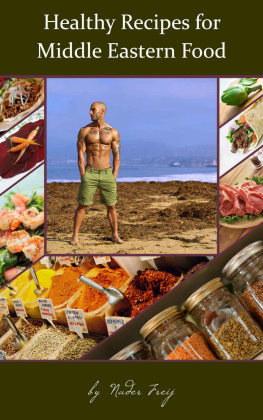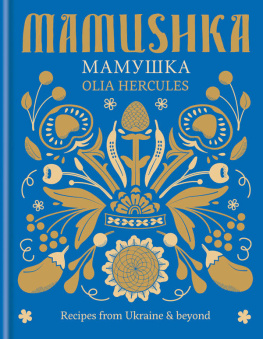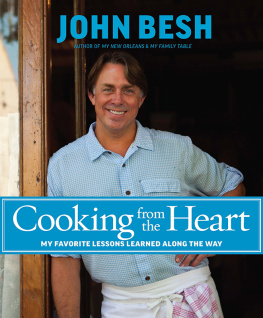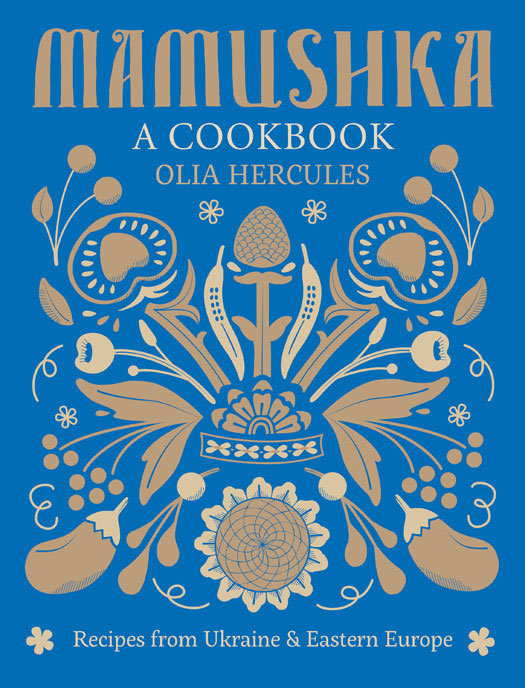
A COOKBOOK
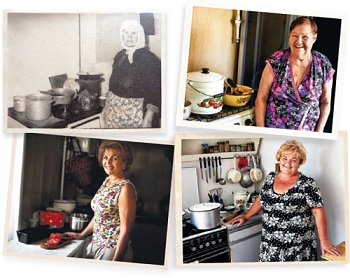
OLIA HERCULES


| Introduction
Mamushka ... is not actually a real word.
My brother Sasha and I watched The Addams Family film for the first time in 1996 (everything came about five years late in post-Soviet Ukraine). And at some point during the movie, a bunch of American actors suddenly spoke a made-up Eastern European language and danced the mamushka the dance of brotherly love taught to the family by their Cossack cousins. Our whole family found this part of the film irresistibly hilarious and since then my brother and I renamed our mum Mamushka .
I now associate the word with strong women in general. I have become a mamushka myself changed careers, worked in restaurants, had a son, and continue to work hard and cook incessantly.
Besides the pure we can do it aspect, mamushka is also about the old and the new. Its about preserving culinary traditions and carrying them over into the modern world. And, boy, is my homeland of Ukraine full of diverse, incredible culinary treasures that deserve to be cherished.
I was born in 1984 in Kakhovka, Ukraine, only two hours drive from the Crimean border. When people suggest that I must be used to the cold, I realize how inextricably bound the Western vision of Ukraine is with that of Russia vast, gray and bleak. Yet the south of Ukraine is only an hour away from Turkey by air. Our winters are mild, our summers long and hot, and our food a cornucopia of color and flavor.
When I think of home, I think of giant sunflower heads and a pink tomato the size of a small grapefruit, with cracks in its sugary skin, ready to be torn and bathed in unrefined sunflower oil. It really was very Jonathan Safran-esque everything was illuminated.
We grew up eating seasonally, as happily there was no alternative. I remember the aroma of the first prickly cucumber in May, my mother chopping it straight over the chipped enamel bowl, then adding the tomatoes, radishes, and a whole bunch of chopped dill, all well seasoned and lightly dressed with smetana the silkiest of soured creams. My favorite part of the meal was dipping a piece of bread into the pool of pink-stained leftover dressing speckled with dill fronds and watching the pink seep into the bread.
Summers were about running through fields of sweet, mustachioed pea pods, popping fresh green morsels into our mouths until our bellies could take no more. There were geese pecking at our mulberry-stained feet and goats that my grandmother christened with dodgy political names one was called Hussein and the other Shevardnadze. Dont even ask.
There was green borshch , bursting with the malachite hue of wilted sorrel along with finely chopped green onion, with shards of boiled egg crowning its surface. I recall sucking the nectar out of acacia and petunia blossoms, a natural outdoor sweet treat, while my aunt sprinkled fresh sour cherries with sugar and then wrapped them in the thinnest of pasta squares, ready to be plunged into a pot of boiling water a dessert to behold! The enticing smells of warm poppy seed cakes, curd cheese cookies, apple cakes, and wasp nest buns are forever fresh in my mind.
Despite my strong Ukrainian identity, I have always cherished and taken pride in the cultural diversity that we were so lucky to enjoy in Ukraine. My paternal grandmother is Siberian, my mother has Jewish and Bessarabian (Moldovan) roots, my father was born in Uzbekistan, and we have Armenian relatives and Ossetian friends. This book is an ode to all those women (and men) whom I was raised by and grew up with, and the food they lovingly prepared. Its food so familiar to me that I hadnt realized it was something special until I became a chef, and even more so when the conflict in Ukraine erupted, prompting me into frantically documenting the recipes that I was so scared I might suddenly lose. This is the stuff of my childhood, a life that I want to share with you in order to dispel the myths about my home country and its surrounding areas and to give the messy geo-political mosaic a human face. As well as a rich history, culture, and traditions, Ukrainians also have that great gift of adaptability and tolerance.
Having started off viewing this project as offering a journey into a little-known culinary quarter for those interested in extending their cultural horizons, I realized when I finished it that it has a universal appeal. There are light, summery dishes along with hearty dishes and broths that make you feel nourished just by inhaling their aromas. There are luscious cakes to titillate any dessert lover, and the fermenting and cheese-making recipes will interest the many permaculturalists out there. While some dishes will take time to prepare, others are gratifyingly quick. And almost all of the material comes from my family, bar a couple of my own recipes that I felt fitted well organically, as I use them a lot.
None of the recipes are prescriptive in the sense that I really hope to encourage you to adapt them to suit individual tastes, as cooking is best when done instinctively. If the dough feels too wet and soft, dont worry about what my recipe says it may be more humid in your kitchen than it was in mine when I made it, so just add more flour. If you hate dill, simply leave it out or add another herb. Nevertheless, do give dill a try, and youll soon discover that its not only good with fish but with many other things besides.
I hope you enjoy looking at my Ukraine through a mamushka s eyes, and I hope you are beguiled by my rather eccentric family stories. But above all, I hope you actually get to do some cooking and enjoy lots of bread dipping, be it in butter, herbs, broths, or sour cream and dill.

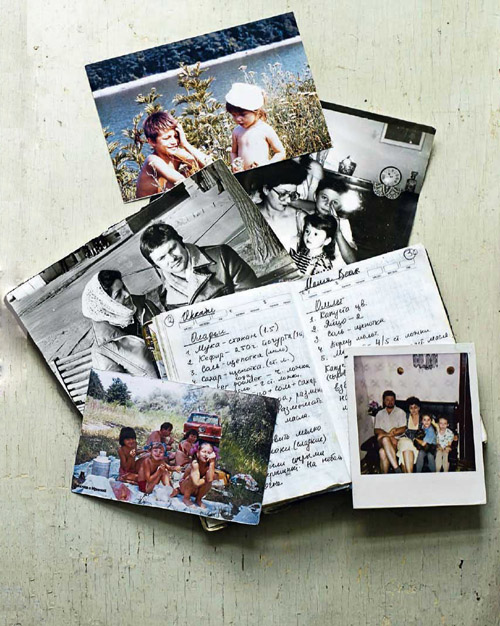
Some useful ingredients
Gherkins Where pickled gherkins are called for, every recipe in this book screams for proper fermented . If you dont make your own, look out for the word kiszony in Polish grocery shops gherkins that have been pickled in vinegar just wont do.
Horseradish leaves, blackcurrant leaves, dill heads & sour cherry leaves These first three ingredients are the typical flavorings used in pickling in Eastern Europe, while sour cherry leaves as well as horseradish leaves have tannins so they help keep your pickles crunchy. I have seen bundles of horseradish leaves and dill heads in Polish grocery shops, but failing that, ask a friend with a garden who may grow the plants or know someone who does, or substitute with dill stalks, mustard seeds, allspice berries, or coriander seeds.
Kefir This fermented milk drink is widely used in Eastern Europe, and we often use it to make . It should be available in Eastern European grocery shops and good supermarkets, but plain yogurt thinned down with a small amount of water is a good enough substitute. People often make it by adding a yeast starter to the milk, but my grandmother and mother simply let the milk go sour, relying on the natural yeasts floating about the kitchen.




